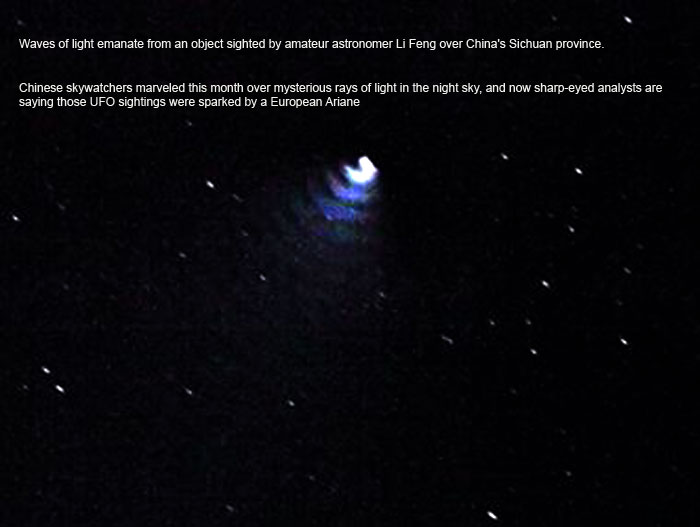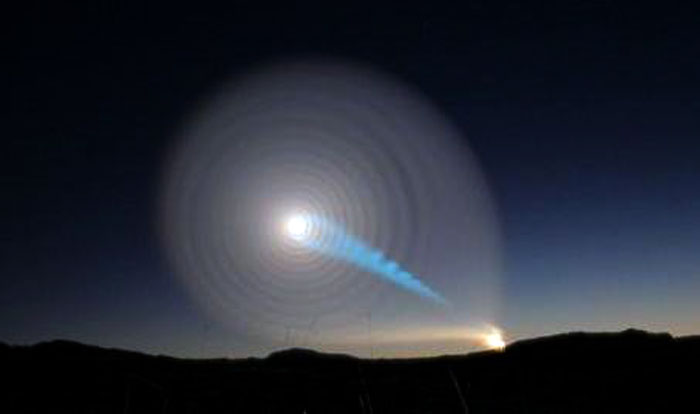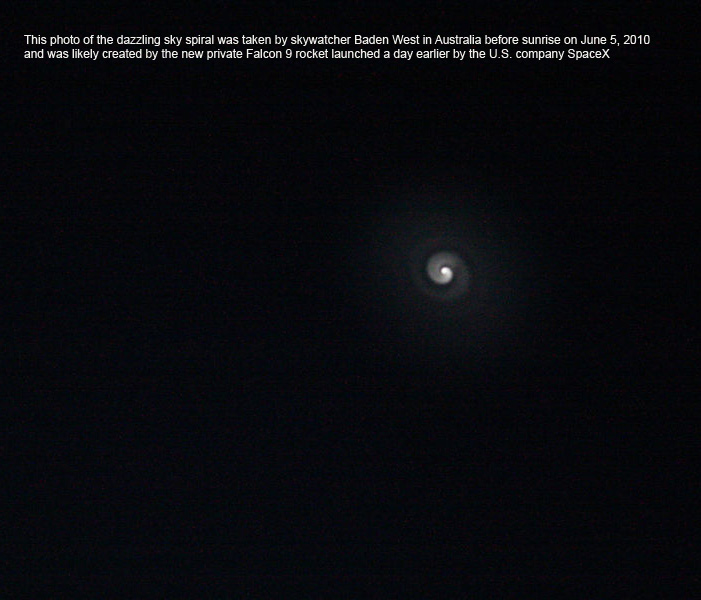-

Chinese skywatchers marveled this month over mysterious rays of light in the night sky, and now sharp-eyed analysts are saying those UFO sightings were sparked by a European Ariane 5 rocket that launched two telecommunication satellites from French Guiana.
Amateur astronomers in China's Sichuan and Yunnan provinces reported seeing the weird phenomenon on Nov. 11. They watched as a luminous object moved through the heavens, shimmering with rays or rings of light. The reports made a splash on Chinese news websites such as Sina.com, as well as the Astronomy.com.cn discussion forum.
"It is certainly a UFO," one forum poster wrote in Chinese. Another wrote that the UFO was a "blessing from another planet." (I couldn't determine how that comment was meant, because my machine-translation software doesn't have a sarcasm filter.)
For a while, Chinese experts speculated that the object might have been a comet — but skywatchers soon figured out that the sightings occurred less than an hour after Arianespace sent the Eutelsat 21B and Star One C3 satellites into orbit (from the European Space Agency's South American spaceport, where it was still Nov. 10).
"The detailed analysis of the height of the UFO and the timing of observation leads me to conclude that this was the ESC-A upper stage, 30 minutes after all the fuel leaked out via passification," a Hong Kong observer known as Galactic Penguin SST reported last week on the NASASpaceflight.com forum.
Today, Want China Times said that the Beijing UFO Research Society has reached a similar conclusion.
"The 'rays' were most likely the rocket jettisoning boosters or other parts and entering low Earth orbit after being launched 30 minutes previously," the Taiwan-based online publication reported. It's also possible that the swirls of light came from fuel or vapor emanating from the upper stage. Such explanations are consistent with a host of other rocket-related UFO sightings over the years, including Russian rocket stages that have been spotted over the Middle East and Scandinavia.
-

Raketen-Ufo-Effekt im Oktober 2009
-
A spectacular spiral light show in the sky above Norway on Wednesday was caused by a Russian missile that failed just after launch, according to Russia's defense ministry.
When the rocket motor spun out of control, it likely created the heavenly spiral of white light near where the missile was launched from a submarine in the White Sea.
The Russian Defense Ministry confirmed that a Bulava ballistic missile test had failed.
"It has been established ... that the missile's first two stages worked as normal, but there was a technical malfunction at the next, third, stage of the trajectory," Reuters quoted a Defense Ministry spokesman as saying.
Paal Brekke, a senior adviser at the Norwegian Space Centre Drammensvn, told Space.com that the cloud was "very spectacular."
"When we looked at the videos people submitted to the media, we quickly concluded that it looked like a rocket or missile out of control, thus the spiraling effect," Brekke said. "I think this is the first time we have seen such a display from a launch failure."
The phenomenon was seen by people all over northern Norway.
"It was a fairly stunning display, and we were really surprised to see it so well-observed," Brekke said.
Viewers described an eerie white cloud with a piercing blue-green beam coming out of it.
6 real-life 'X-Files'"It consisted initially of a green beam of light similar in color to the aurora with a mysterious rotating spiral at one end," Nick Banbury of Harstad, Norway, told Spaceweather.com. "This spiral then got bigger and bigger until it turned into a huge halo in the sky with the green beam extending down to Earth."
Banbury said he saw the lights on his way to work between 7:50 and 8 a.m. local time, or 1:50 to 2 a.m. ET Wednesday.
"We are used to seeing lots of auroras here in Norway, but this was different," he said.
Before the missile test was confirmed, many people suggested the bright light pattern might have been a UFO. Russia finally admitted to the accident, which is an embarrassing mishap for a rocket that had already failed six of 13 previous tests, according to the BBC.
The Bulava missile is designed to carry six individually targeted nuclear warheads over a range of up to 6,200 miles (10,000 km), the BBC reported. The missile had been touted as Russia's newest technological breakthrough to support its nuclear deterrent, but the numerous failures have led to second thoughts.
"This is a catastrophe ... Huge funds were siphoned off from Russia's moribund navy for the Bulava project. In fact, billions of dollars have been flushed down the drain," Alexander Khramchikhin, chief analyst at the Moscow-based Institute of Military and Political Analysis, told Reuters.
Analysts criticize Moscow's hurry to build the Bulava, as it already has a highly reliable Soviet-built Sineva submarine-based ballistic missile. They also question awarding the Bulava contract to the Moscow Institute of Thermal Technology, which has never before built missiles for submarines.
-
In an ironic encore, yet another secret military missile test has sparked widespread UFO reports from surprised ground witnesses.
On Dec. 9, a Russian Bulava missile was launched from a submarine within sight of northern Norway, resulting in a spectacular spiral display and a spate of UFO sightings.
This week's UFO reports apparently were sparked by a Chinese missile that was fired to intercept another missile in flight, for the first time in the nation's history.
Witnesses in China's inland provinces of Xinjiang and Gansu weren’t as well equipped with cameras as last month's Norwegian witnesses were, so the only images reaching the West merely show fuzzy-colored clouds and streaks. The military secrecy surrounding China's missile test is so tight that Beijing officials seem to be at a loss as to how to respond to the reports.
As with December's Russian missile test, cases such as these underscore how important it is for intelligence agencies to seek out and evaluate reports of unidentified flying objects from countries of interest. For decades, such reports from the Soviet Union and China might have provided hints about top-secret military missiles and space weapons. The stories would be most valuable precisely because the unidentified flying objects were not true “UFOs” at all.
Great leap for China's missile shield
China’s latest military space maneuver came to light on Monday when a single-sentence news item was released by the Xinhua news agency. “China conducted a test on ground-based midcourse missile interception within its territory on Monday,” Xinhua reported. An hour later, two sentences were added: “The test has achieved the expected objective. The test is defensive in nature and is not targeted at any country.”
No other details have been released. The names, or even the generic types, of missiles weren’t given. The locations of the two missile launches — for the target and the interceptor — were never specified, nor was the time of their launches. In contrast, Moscow quickly provided such data for last month's missile test.
Advertise | AdChoices
Speculation in the Western press went on for days without converging on any consensus, except that the warhead had been a ‘hit-to-kill’ guided missile, probably closely related to the anti-satellite warhead used three years earlier to smash a derelict Chinese satellite. The altitude of the intercept and the maximum speed of any target missile was not clear.
Hints from the hinterland
Chinese military officials are well aware of the extent to which the U.S. military officials (and to a lesser degree the Russians) keep a close watch on their activities. China has an active program of camouflage and misdirection to hide their secrets.
Civilian UFO reports, however, don't always follow the program. UFO Web sites in China and overseas began picking up detailed reports from ground observers, telling of an amazing celestial light show that occurred about an hour before Beijing's first official announcement.
Six real-life 'X-Files'At a coal mine in eastern Xinjiang, an engineer named Ma reported: “I and my 45 colleagues from the mine came out. I suddenly sensed the color of the sky becoming ever brighter. In the southwest there were clusters of green, moving toward the east slowly. … Blue light issued waves that rotated for several minutes, and then came down on a nearby mountain.”
A man named Daw who lives in Mori county, on the Mongolian border, said: "My friends and I were walking home. Suddenly we saw the sky had a bright spot in the west, it was spinning in clockwise movement toward the south. It was surrounded by a white fog that constantly expanded. In the center there also appeared a blue iris that expanded, then gradually faded and finally disappeared. "
A man named Shi who worked in the Grand Canyon Park in Xinjiang's Tian Shan Mountains said "there was a light in the sky, a light blue ball, a horizontally fast-moving ball of light. Then it collided with an unknown object, resulting in an explosion, and this produced two white circular light waves."
A worker at the Jiuquan space center in Gansu province provided a detailed report about a "white circular structure about the size of dozens of moons." The worker said the display "quickly expanded to half of the sky, and then gradually faded."
After wondering whether the flash was a nuclear explosion, the worker said "my colleagues and I then guessed that it may be an alien voyager from another planet." The display lasted just two or three minutes, the worker said.
Decoding the narratives
Space and missile experts will now be working with these and other stories, and with whatever photographs manage to slip out of China. The information may help supplement much more detailed measurements from U.S. military assets. The result could provide significant insights into the nature of the interceptor’s kill mechanism and the range of its potential target missiles.
Some caution is still prudent. So far there's no confirmation from U.S. military intelligence sources that the Chinese missile test did in fact occur at about 8 p.m. local time (7 a.m. ET) on Monday, when the UFO sightings were made. However, the timing is consistent with the way Beijing released information about the test.
It might turn out to be a complete coincidence, and the reports might be due to something else entirely — even a real flying saucer. But the Chinese have a long history of reporting space and missile events as UFOs, and with the Norway experience so fresh in our minds, reaching a similar conclusion is reasonable.
The eyewitnesses got quite a thrill, as have UFO buffs who are welcoming this latest news as further proof of the imminence of alien arrivals on Earth. The Chinese military teams who pulled off the intercept have every reason to feel proud of the successful mission.
If the UFO reports and the missile test reports indeed refer to the same event, the people least happy about the whole affair could well be China's security forces — who may have seriously underestimated how well their own people are watching the skies, and how quickly they can report their observations.
NBC News space analyst James Oberg spent 22 years at the Johnson Space Center as a Mission Control operator and an orbital designer. He is the author of nine books on space policy and phenomena, including "Space Power Theory" and "UFOs and Outer Space Mysteries."
-

An eerie spiral light show in the pre-dawn sky over Australia early Saturday prompted a flood of UFO reports to local news stations, but was likely just the remnants of a new private rocket launched by an American millionaire, according to Australian media reports.
The bright sky spiral appeared before sunrise on Saturday over New South Wales, Queensland and the Australia Capital Territory (ACT), with witnesses describing it as a "lollipop-type swirl," the Australia Broadcasting Corp. (ABC) reported.
"The spiral looked like a bright light shining through some clouds in a spiral shape, except the edges of the spiral were very sharp and defined unlike what a cloud might look like," Baden West, who snapped photos of the spiral before it faded from view, told SPACE.com in an e-mail. "It was also very large, much bigger than any photo makes it look and in terms of brightness. It looked like it was about as bright as a full moon but all the light was coming from a much smaller point."
One witness, James Butcher of Canberra, told ABC that the spiral light appeared to have a yellow hue.
Another skywatcher described the sky apparition as a "huge revolving moon," according to ABC.
But despite claims of otherworldly origins, the phenomenon was likely created by the new Falcon 9 rocket launched from Cape Canaveral, Fla., by Space Exploration Technologies (SpaceX), a California-based spaceflight company led by millionaire PayPal co-founder Elon Musk.
"I heard people in Australia thought UFOs were visiting :)," SpaceX's millionaire founder Elon Musk told SPACE.com in an e-mail. "The venting of propellants, which is done to ensure that an overpressure event doesn't produce orbital debris, created a temporary halo caught the sun at just the right angle for a great view from Australia. I thought the pictures looked really cool." [See the sky spiral.]
Professional skywatchers quickly suggested that SpaceX's first Falcon 9 rocket may be the source of the sky spiral, ABC reported
"The fact that you've got the rotation, the spiral effect, is very reminiscent of the much widely reported sightings from Norway and Russia last year, which both turned out to be a Bulava missile which was being adjusted in its orbit," Geoffrey Whyatt of the Sydney Observatory told ABC. "So possibly a rocket, I would say, having some sort of gyroscopic stability rocket fired on its side."
The Bulava missile spiral occurred in December 2009 and also set off a flurry of UFO reports from observers on the ground, as well as resulting in spectacular photos.
The new Falcon 9 blasted off Friday afternoon from Cape Canaveral Air Force Station on a successful test flight that reached an orbit of about 155 miles (250 km) above Earth.
SpaceX plans to use the two-stage Falcon 9 rocket to launch its own Dragon spacecraft on unmanned cargo flights to the International Space Station for NASA under a $1.6 billion contract with the U.S. space agency.
Musk also hopes to add an emergency launch escape system to the 180-foot (55-meter) tall rocket and refit the Dragon spacecraft to launch astronauts into space.
NASA plans to retire its three aging space shuttles later this year after two final missions and rely on commercial spacecraft to send astronauts and cargo into orbit.
-
Quelle: space
7662 Views
